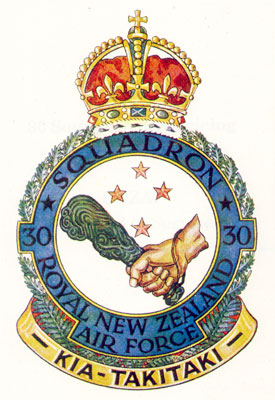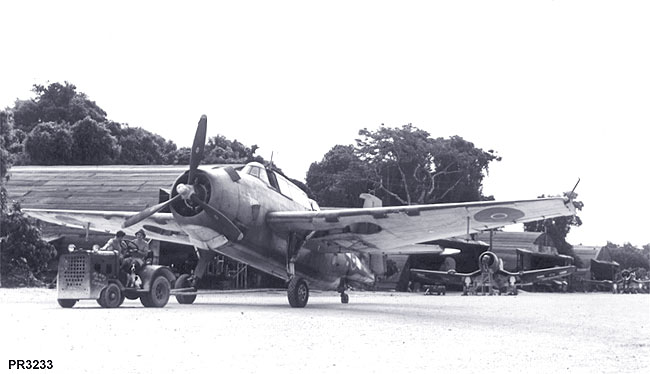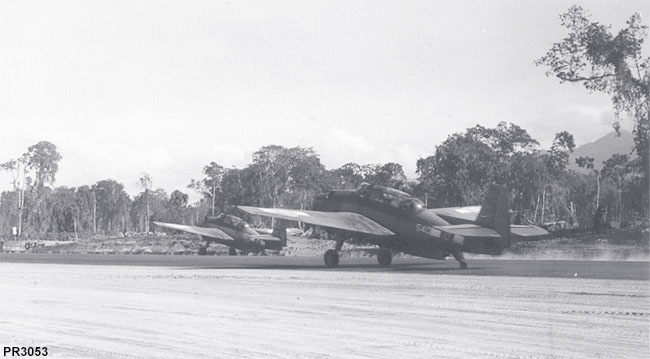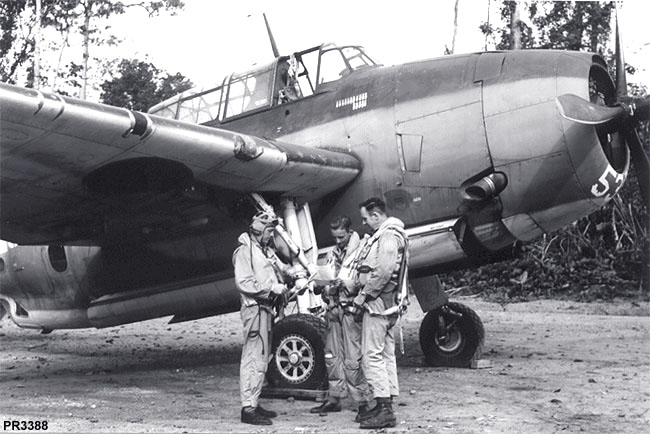
|
OPERATIONAL USE |

|
30 Squadron and 30 Servicing Unit: After completing their initial training on the Avengers at Gisborne, 30 Squadron began a shift to the forward area via Whenuapai Airbase in Auckland on January 24th, 1944. The aircraft were prepared for their long ferry flight, and final leave was granted to the aircrews. 30 Servicing Unit personnel
travelled by bus, then train to Auckland where they joined with 25 Servicing
Unit who were to service the Dauntless's of 25 Squadron who were
also to operate from Bougainville.
On 26th January, the first flight of nine aircraft, escorted by two Hudson's from 40 Transport Squadron as navigation and safety aircraft, left for Espiritu Santo via Norfolk Island and TonTouta, New Caledonia, arriving at Luganville Field on Espiritu Santo on the 27th. The second flight of nine aircraft left Whenuapai on the 28th, and after several incidents with burst tailwheels at Norfolk Island and TonTouta forced stopovers, arrived safely at Luganville on the 30th. A small advance party from 30 Servicing Unit travelled in the escorting Hudsons with the remainder leaving on the liberty ship USS Alsheba on February 2nd, and after an apparently tedious voyage where they only received two meals a day, arrived at Espiritu Santo on February 10th.
|

|
NZ2547
photographed at Luganville Field on Espiritu Santo in early 1944.
This was one of three replacement
|
|
After they had become established, 30 Squadron then began their forward area training. They
were fortunate in that they were to share this period of training
with VMTB232, an experienced Marine Squadron operating TBF's who were preparing
for another tour in the forward area. The skills learnt during this
time were to help 30 Squadron immensely during the period ahead,
and the friendships formed were to carry on to the present day.
On the 7th of March the ground crew and equipment of 30 Servicing Unit, and many of the non flying personnel of 30 Squadron (along with those of 25 Servicing Unit) embarked on a US Navy Transport ship, AK 127 (USS Alnida) for Bougainville. The ship sailed via Guadalcanal, and arrived at Bougainville on March 15th where they were ferried ashore in amphibious 'Duck's' to the accompaniment of shellfire from the many allied warships gathered off Empress Augusta Bay. Their arrival was at the height of the major Japanese counter attack on the beachhead area, which at this time was only to a depth of three miles inland, and a width of four miles along the coast! The 30 Servicing Unit camp area was only 1000 yards from the front line, so the men were armed at all times, and had to share guard duties with the US forces. 30 Squadron
flew their aircraft (with extra passengers from the skeleton crew from
30 Servicing Unit left behind to look after the aircraft) to Guadalcanal
on March 23rd, escorted by PV-1 Venturas which also carried some of the
remaining 30 Servicing Unit personnel.
On the 24th,
after a three hour flight, 30 Squadron's aircraft touched down at Piva
on Bougainville, just as the Japanese guns in the hills above were
shelling the airstrip! Fortunately all landed safely with no damage.
On the morning of the 25th, they went straight into action, along with the SBD's of 25 Squadron, bombing and strafing the Japanese gun positions and troop concentrations around the perimeter. They only had to take off, fly a circuit and bomb before coming in to reload. This was to be the pattern for the next fortnight, bombing during the day, and patrolling the perimeter during the night. During this
period, sporadic shelling of the camp areas by the Japanese, by day and
night, made sleep almost impossible, and 30 Squadron and 30 Servicing
Unit crews were operating under great stress.
The first
major action was on March 26th when a combined raid was carried out on
Kavieng airstrip on New Ireland to support the American landings on Emirau
Island. Much accurate damage was caused to the strip, and the 30
Squadron crews were commended by the Commander Air Solomons, General H.R.Harmon.
During this action, NZ2510 received major damage to a wing, and had to
make an emergency landing on Green Island. The 'Joker' apparently
received the replacement wing from a TBF-1, and by all accounts was
never the same aircraft again!
The first major operation against Vunakanau came on 9th April when Flight Lieutenant N. H. James of 30 Squadron led a mixed group of 93 RNZAF and USMC TBF's and SBD's on a successful strike. Much damage was caused to the runway, but two of 30 Squadrons aircraft, NZ2512 and NZ2518 received hits from AA fire. The format of a typical mission was as follows, quoting a passage from 'The Avengers' by Wally Ingham: Therefore each mission was usually shared by SBD's and TBF's, the majority being SBD's employed as dive bombers who's task it was to go in first and dive-bomb the anti-aircraft batteries, primarily to destroy the guns, and secondarily to put the gunners off their aim and force them to take cover. The TBF's would immediately follow and plant their bombs on the runways and personnel areas. The size of each force varied according to the specific target but the average mission usually contained 40-60 SBD's and at least 12-24 TBF's plus fighter escorts, and it was not uncommon to have over 100 aircraft coordinating on one mission. F/0 L Hadlow recalls the tactics very vividly "From the time we left Piva we would climb steadily until we reached at least 14,000 feet altitude over the target area flying loosely in groups of 3 aircraft. Taking our cue from the SBD's who would dive bomb the defenses, we would immediately follow our leader in a high speed shallow dive in the direction of the target, leveling out at 8,000 feet altitude, followed by a steep wing-over and dive (about 45 degrees) down to 2000' on to the target. In each case the maximum speed (red line marking) was exceeded reaching 350 knots or more if one was to survive. On releasing our bombs we would fly even lower (it being instant suicide to pull-up in a climb, as the AA would have easily picked us off, and our one chance of survival was to keep as low as possible) until we reached the coast at sea level, and got out to sea and out of range of their AA defenses" The first
operational loss was NZ2507 which crashed with the loss of her crew
(Pilot F/O R.D. Gardner, Navigator P/O C. Nichols and Gunner
P/O P. Shearer) after being hit by AA fire over Vunakanau on
26th April, 1944. This loss was to affect the members of 30
Squadron and 30 Servicing Unit deeply, as Gardner and his crew had been
with 30 Squadron since its formation.
|

|
30 Squadron TBF's taxy at Piva North on Bougainville, March 1944. Note roundels on wings, and stencilled last three of serial on fuselage ahead of the roundel. |
|
Targets attacked on Bougainville itself included barges, trucks, supply dumps and personnel. By the end of April, 30 Squadron had carried out 19 major strikes, 16 minor strikes, recorded a total of 649 bombs dropped, lost one aircraft and crew to enemy action, and suffered damage to 10 aircraft due to enemy action. Their tour was due to finish soon, but was delayed by two weeks due to problems in getting their replacements, 31 Squadron, up to operational standards. Much concern was expressed at this time by the senior officers of 30 Squadron that 31 would be going straight into action without the benefit of the forward area training that 30 Squadron had experienced. This concern was well founded as shown by the losses that 31 Squadron were to suffer during their tour. A further cause of aggravation and bitterness to 30 Squadron, was the decision by RNZAF Operations Staff to carry out a strike on the Rabaul airfields involving only the TBF's of 30 Squadron and the SBD's of 25 Squadron (who were also reaching the end of their tour) as a propaganda exercise. These Strikes would normally be carried out by up to 100 aircraft, not by the 30 or so able to be made serviceable. Despite the objections of both the 30 and 25 Squadron Commanders, S/Leader Noel James and S/Leader T.L. MacLean de Lange, the strike was ordered to proceed as planned on the 10th of May. The strike went ahead, and 30 Squadron were to lose NZ2541 with it's crew of pilot F/O A.M. Bailey, the navigator, F/Sgt. L.G. Schlesinger and the gunner, W/O. R. Curtis. Many of the other aircraft received damage from the intense AA fire met. 25 Squadron also lost NZ5051 with it's crew of F/Lt. J. Edwards and gunner F/Sgt. Hoppe. Further strikes were carried out on the 11th and 12th of May, but were combined strikes, accompanied by up to 48 SBD's to suppress the AA positions. The last major strike of 30 Squadrons' tour was carried out on 14th May against Vunakanau strip and luckily only one aircraft, NZ2514 received damage with no crew injuries. |

|
TBF-1C NZ 253?? and 30 Squadron crew, Piva, Bougainville. Note mission markings of 16 small Yellow bombs on starboard upper cowl. An enlargement of this appears in the colours and markings section. |
|
The last mission carried out was on the 22nd of May when 12 of 30 Squadrons' TBF's struck a supply area south of Tahili Bay. All aircraft returned safely with minor damage to one aircraft, Fred Ladd's NZ2518 'Plonky', which had a cockpit window blown out. On the 23rd May, Marine crews borrowed 30 Squadron's aircraft and on return they highly praised their condition. Their comments were music to 30 Servicing Unit who had worked extremely hard under very trying conditions to keep them this way. Later on S/Ldr Noel James was to write, "My aircraft was NZ 2513 and I flew it on all missions except when it was on inspection. She never missed a beat any time I flew her. The maintenance was unsurpassed, and of the highest standard. On occasions when we lent our aircraft to the American squadrons, their crews were astounded at how well our aircraft were maintained. Also I remember there were very few days that we didn't have 100% availability of all aircraft. That must be some record for servicing under tropical conditions. The armourers were simply magnificent, goodness knows how many times strike command changed their minds about bomb loads, but it was done and we dropped them." Extract from 'The Avengers'. On the 25th of May, an RNZAF C47 arrived with the 31 Squadron crews, and 30 Squadron departed the same day for New Zealand and a well earned rest. 30 Servicing Unit were remaining behind to maintain the aircraft for 31 Squadrons' tour, so had little time to relax. |